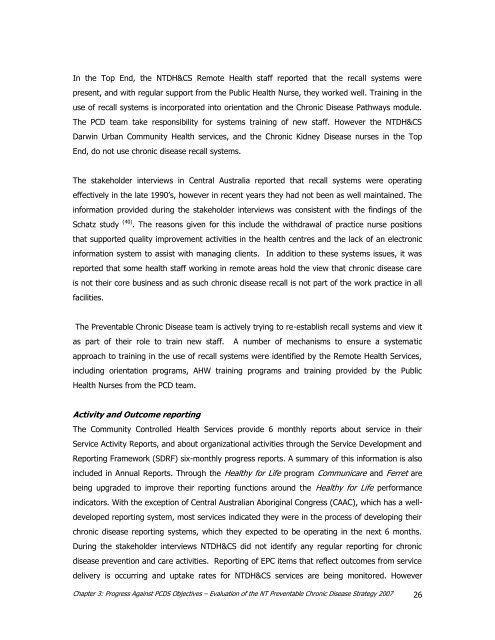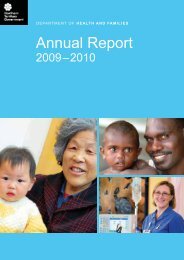PCD Strategy Evaluation 2007.pdf - NT Health Digital Library ...
PCD Strategy Evaluation 2007.pdf - NT Health Digital Library ...
PCD Strategy Evaluation 2007.pdf - NT Health Digital Library ...
Create successful ePaper yourself
Turn your PDF publications into a flip-book with our unique Google optimized e-Paper software.
In the Top End, the <strong>NT</strong>DH&CS Remote <strong>Health</strong> staff reported that the recall systems werepresent, and with regular support from the Public <strong>Health</strong> Nurse, they worked well. Training in theuse of recall systems is incorporated into orientation and the Chronic Disease Pathways module.The <strong>PCD</strong> team take responsibility for systems training of new staff. However the <strong>NT</strong>DH&CSDarwin Urban Community <strong>Health</strong> services, and the Chronic Kidney Disease nurses in the TopEnd, do not use chronic disease recall systems.The stakeholder interviews in Central Australia reported that recall systems were operatingeffectively in the late 1990‟s, however in recent years they had not been as well maintained. Theinformation provided during the stakeholder interviews was consistent with the findings of theSchatz study (40) . The reasons given for this include the withdrawal of practice nurse positionsthat supported quality improvement activities in the health centres and the lack of an electronicinformation system to assist with managing clients. In addition to these systems issues, it wasreported that some health staff working in remote areas hold the view that chronic disease careis not their core business and as such chronic disease recall is not part of the work practice in allfacilities.The Preventable Chronic Disease team is actively trying to re-establish recall systems and view itas part of their role to train new staff. A number of mechanisms to ensure a systematicapproach to training in the use of recall systems were identified by the Remote <strong>Health</strong> Services,including orientation programs, AHW training programs and training provided by the Public<strong>Health</strong> Nurses from the <strong>PCD</strong> team.Activity and Outcome reportingThe Community Controlled <strong>Health</strong> Services provide 6 monthly reports about service in theirService Activity Reports, and about organizational activities through the Service Development andReporting Framework (SDRF) six-monthly progress reports. A summary of this information is alsoincluded in Annual Reports. Through the <strong>Health</strong>y for Life program Communicare and Ferret arebeing upgraded to improve their reporting functions around the <strong>Health</strong>y for Life performanceindicators. With the exception of Central Australian Aboriginal Congress (CAAC), which has a welldevelopedreporting system, most services indicated they were in the process of developing theirchronic disease reporting systems, which they expected to be operating in the next 6 months.During the stakeholder interviews <strong>NT</strong>DH&CS did not identify any regular reporting for chronicdisease prevention and care activities. Reporting of EPC items that reflect outcomes from servicedelivery is occurring and uptake rates for <strong>NT</strong>DH&CS services are being monitored. HoweverChapter 3: Progress Against <strong>PCD</strong>S Objectives – <strong>Evaluation</strong> of the <strong>NT</strong> Preventable Chronic Disease <strong>Strategy</strong> 2007 26
















